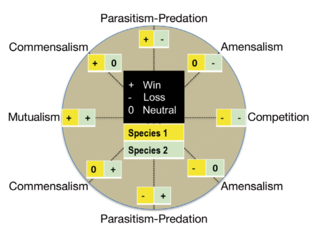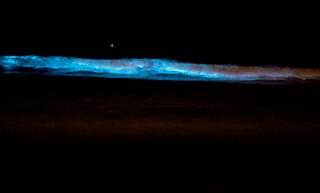



Bioluminescence is the production of light by living organisms. This list of bioluminescent organisms is organized by the environment, covering terrestrial, marine, and microorganisms.




Bioluminescence is the production of light by living organisms. This list of bioluminescent organisms is organized by the environment, covering terrestrial, marine, and microorganisms.


Zooplankton are the animal component of the planktonic community, having to consume other organisms to thrive. Plankton are aquatic organisms that are unable to swim effectively against currents. Consequently, they drift or are carried along by currents in the ocean, or by currents in seas, lakes or rivers.

Bioluminescence is the production and emission of light by living organisms. It is a form of chemiluminescence. Bioluminescence occurs widely in marine vertebrates and invertebrates, as well as in some fungi, microorganisms including some bioluminescent bacteria, and terrestrial arthropods such as fireflies. In some animals, the light is bacteriogenic, produced by symbiotic bacteria such as those from the genus Vibrio; in others, it is autogenic, produced by the animals themselves.

Aliivibrio fischeri is a Gram-negative, rod-shaped bacterium found globally in marine environments. This species has bioluminescent properties, and is found predominantly in symbiosis with various marine animals, such as the Hawaiian bobtail squid. It is heterotrophic, oxidase-positive, and motile by means of a single polar flagella. Free-living A. fischeri cells survive on decaying organic matter. The bacterium is a key research organism for examination of microbial bioluminescence, quorum sensing, and bacterial-animal symbiosis. It is named after Bernhard Fischer, a German microbiologist.

A salp or salpa is a barrel-shaped, planktonic tunicate in the family Salpidae. It moves by contracting, thereby pumping water through its gelatinous body; one of the most efficient examples of jet propulsion in the animal kingdom. The salp strains the pumped water through its internal feeding filters, feeding on phytoplankton.

Pyrosomes, genus Pyrosoma, are free-floating colonial tunicates that usually live in the upper layers of the open ocean in warm seas, although some may be found at greater depths. Pyrosomes are cylindrical or cone-shaped colonies up to 18 m (60 ft) long, made up of hundreds to thousands of individuals, known as zooids. Colonies range in size from less than one centimeter to several metres in length. They are commonly called "sea pickles". Other nicknames include "sea worms", "sea squirts", "fire bodies", and "cockroaches of the sea".

Noctiluca scintillans is a marine species of dinoflagellate that can exist in a green or red form, depending on the pigmentation in its vacuoles. It can be found worldwide, but its geographical distribution varies depending on whether it is green or red. This unicellular microorganism is known for its ability to bioluminesce, giving the water a bright blue glow seen at night. However, blooms of this species can be responsible for environmental hazards, such as toxic red tides. They may also be an indicator of anthropogenic eutrophication.

Milky seas, also called mareel, is a luminous phenomenon in the ocean in which large areas of seawater appear to glow translucently. Such occurrences glow brightly enough at night to be visible from satellites orbiting Earth.
Luminescent bacteria emit light as the result of a chemical reaction during which chemical energy is converted to light energy. Luminescent bacteria exist as symbiotic organisms carried within a larger organism, such as many deep sea organisms, including the Lantern Fish, the Angler fish, certain jellyfish, certain clams and the Gulper eel. The light is generated by an enzyme-catalyzed chemoluminescence reaction, wherein the pigment luciferin is oxidised by the enzyme luciferase. The expression of genes related to bioluminescence is controlled by an operon called the lux operon.
Chaetopterus pugaporcinus, commonly known as the pigbutt worm or flying buttocks, is a species of worm first described by scientists at the Monterey Bay Aquarium Research Institute in 2007. The worm is round in shape, approximately 10 to 20 millimeters in length, and bears a strong resemblance to a disembodied pair of buttocks. Because of this, it was given a Latin species name that roughly translates to "resembling a pig's rear."

Atolla wyvillei, also known as the Atolla jellyfish, Coronate medusa, and deep-sea jellyfish, is a species of deep-sea crown jellyfish. It lives in oceans around the world. Like many species of mid-water animals, it is deep red in color. This species was named in honor of Sir Charles Wyville Thomson, chief scientist on the Challenger expedition.

Pyrocystis fusiformis is a non-motile, tropical, epipelagic, marine dinoflagellate, reaching lengths of up to 1 millimetre (0.039 in). P. fusiformis display bioluminescence when disturbed or agitated. In coastal marine waters, this dinoflagellate causes glowing effects after dark. P. fusiformis was first described in the Proceedings of the Royal Society of London in 1876.

Dyakiidae is a family of air-breathing land snails terrestrial pulmonate gastropod mollusks in the superfamily Trochomorphoidea.

Quantula striata, also known as Dyakia striata, is a species of medium-sized, air-breathing, tropical land snail. It is a terrestrial, pulmonate, gastropod mollusk in the family Dyakiidae. This species appears to be unique among terrestrial gastropods in that it is bioluminescent: Its eggs glow in the dark, and juveniles and most adults give off flashes of green light.
Phuphania is a genus air-breathing, tropical land snails. It is a terrestrial, pulmonate, gastropod mollusc in the family Dyakiidae. All members of this genus display bioluminescence.

Underwater camouflage is the set of methods of achieving crypsis—avoidance of observation—that allows otherwise visible aquatic organisms to remain unnoticed by other organisms such as predators or prey.

Motyxia is a genus of cyanide-producing millipedes that are endemic to the southern Sierra Nevada, Tehachapi, and Santa Monica mountain ranges of California. Motyxias are blind and produce the poison cyanide, like all members of the Polydesmida. All species have the ability to glow brightly: some of the few known instances of bioluminescence in millipedes.

Bioluminescent bacteria are light-producing bacteria that are predominantly present in sea water, marine sediments, the surface of decomposing fish and in the gut of marine animals. While not as common, bacterial bioluminescence is also found in terrestrial and freshwater bacteria. These bacteria may be free living or in symbiosis with animals such as the Hawaiian Bobtail squid or terrestrial nematodes. The host organisms provide these bacteria a safe home and sufficient nutrition. In exchange, the hosts use the light produced by the bacteria for camouflage, prey and/or mate attraction. Bioluminescent bacteria have evolved symbiotic relationships with other organisms in which both participants benefit close to equally. Another possible reason bacteria use luminescence reaction is for quorum sensing, an ability to regulate gene expression in response to bacterial cell density.

Microbial symbiosis in marine animals was not discovered until 1981. In the time following, symbiotic relationships between marine invertebrates and chemoautotrophic bacteria have been found in a variety of ecosystems, ranging from shallow coastal waters to deep-sea hydrothermal vents. Symbiosis is a way for marine organisms to find creative ways to survive in a very dynamic environment. They are different in relation to how dependent the organisms are on each other or how they are associated. It is also considered a selective force behind evolution in some scientific aspects. The symbiotic relationships of organisms has the ability to change behavior, morphology and metabolic pathways. With increased recognition and research, new terminology also arises, such as holobiont, which the relationship between a host and its symbionts as one grouping. Many scientists will look at the hologenome, which is the combined genetic information of the host and its symbionts. These terms are more commonly used to describe microbial symbionts.
Life That Glows is a 2016 British nature documentary programme made for BBC Television, first shown in the UK on BBC Two on 9 May 2016. The programme is presented and narrated by Sir David Attenborough.

Scintillons are small structures in cytoplasm that produce light. Among bioluminescent organisms, only dinoflagellates have scintillons.